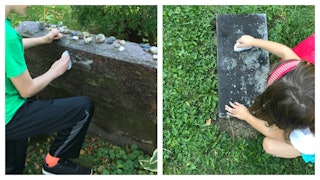We Spent The Day At The Cemetery

“Hey, kids! Let’s go scrub gravestones at the cemetery!” Not exactly what I said, but close.
This past weekend, on Sunday morning, I whirled into Target, past the people picking up their Starbucks before church, and into the cleaning supplies aisle to pick up two buckets and three scrub brushes, and a pair of rubber gloves. I could have gotten this all ahead of time, but let’s get real: My heart is always in the right place, but my mind has trouble keeping up.
I love cemeteries. Not because I like death or gore or ghosts or anything of the sort. I love the stones, the names, and the stories. I love the idea that cemeteries are kind of like neighborhoods of people. Those people just happen to be dead.
My grandmother died when I was 6. I stayed at the house while the family went to the burial. All I remember was seeing a huge fruit basket enter the house with a giant, shiny bow atop. Death, aside from absence, meant fruit baskets.
I used to feel as a kid that my grandma’s ghost would come and visit me at night while I was falling asleep. I could feel her sitting at the foot of my bed. I named my daughter after her.
In high school, I did a lot of babysitting for a family whose backyard was a Jewish cemetery. Their lawn was the size of a postage stamp and they had these low boxwoods to demarcate the property line and then… headstones. The house was older, and at night when the kids were asleep, the house would settle, which scared the shit out of me. I called my mom and made her come and search the house at least a couple of times. At some point, I finally came up with a thought that helped: The cemetery was Jewish. I was Jewish. The ghosts of Jews would surely not want to haunt one of their own. I was safe.
Death was not something that was talked about in my house, which I think, in retrospect, made it scarier. I made a conscious decision with my kids that I would never shy away from death as a topic. I wouldn’t glorify it or fixate on it, but I wouldn’t shy away from it either.
Every religion has its own take on death and afterlife; every person has some derivative thereof or not. Our thoughts about death are just as varied as those about life. When I talk to my kids about death, we talk about what different people believe. My daughter seems to currently believe in reincarnation (makes sense for a child who has always seemed like an old soul).
My bottom line is always that there is no way to know what happens to us after we die. But if we live a good life, if there is some kind of an afterlife, we won’t have to worry about what happens to us. My focus is always on living. A friend of mine from junior high, who was always wise beyond her years, had a quote that has stuck with me to this day: “Live while you live and then die and be done with it.” That seems to hold up pretty well.
I’m not terribly concerned about where I end up when I die. (Should I be buried? Cremated? Natural burial? Funeral pyre? Should I request everyone do a flash mob of my favorite kickboxing routine? Or maybe “When you’re a Jet, you’re a Jet for life?”) All good choices. Or not. It’s not going to matter because I will be dead, and that’s okay.
When my husband and I visited Berlin in the early 2000s, we made a pilgrimage over to East Berlin to visit the Jewish cemetery. It was vast, and much of it had heaved and settled over time. Heavily forested, many of the headstones seemed as though they had been untouched for decades, if not longer. Lichens and moss piggybacked one another to encase the stones, fill in the empty space of letters and names. This is what time does.
We stopped in our tracks in front of an obviously prestigious family tomb, the large slab of granite cracked almost completely down the middle, as though struck by lightening. Growing out of the rift was a large tree. The family name? Baum. The German word for tree. It was scary and natural and amazing and perfect. Not sure that you could have planned it that way, but again, that’s like life.
So with our brushes and our buckets and gloves, we drove to the cemetery. We met with my kids’ Sunday school group. The rabbi talked about the mitzvah (good deed) of caring for the graves of loved ones during the time between the Jewish holidays of Rosh Hashana and Yom Kippur.
My family has no graves in this town. But some people’s families did, and they took us to those graves and told us a little bit about their relatives. Then we fanned out. My daughter had seen a particular stone that she thought needed her attention. My son started with a stone that had the family name of his Hebrew tutor.
It was satisfying work. Uncovering names and dates. Making things legible. Would the dead care that we were doing this? I don’t know. Doesn’t matter, really. There might be someone who comes back to find their relative, and it’s maybe lovely to know that someone had been there to visit and care.
Mourning and death and memory are so easily fractured into a thousand pieces, each of us carrying within ourselves tiny universes of dust and shards and light. Caring for others — in death as in life — helps sweep the shards together. Look at all the beautiful little pieces of meaning and history and love. They are not yours or mine, but ours.
This article was originally published on